Top speed 356 km/h Retired 1956 Length 36 m First flight 1941 | Introduced 1945 Wingspan 61 m | |
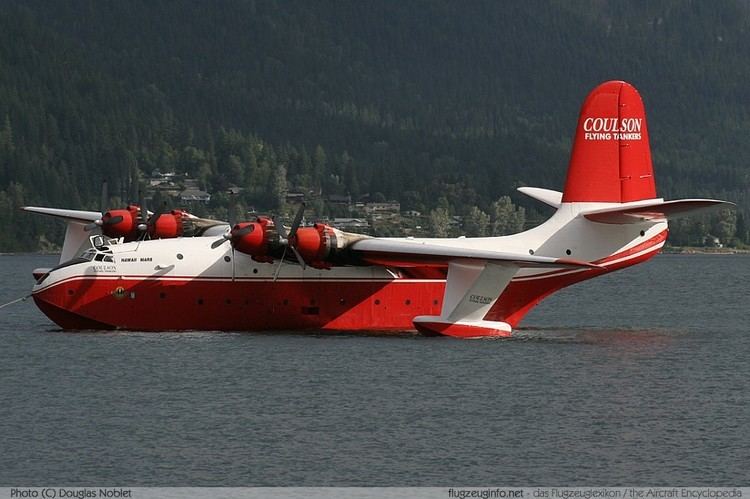 | ||
Martin jrm mars hawaii mars water bomber approach and landing
The Martin JRM Mars is a large, four-engined cargo transport seaplane originally designed and built in limited numbers for the U.S. Navy during the World War II era. It was the largest Allied flying boat to enter production, although only seven were built. The United States Navy contracted the development of the XPB2M-1 Mars in 1938 as a long range ocean patrol flying boat, which later entered production as the JRM Mars long range transport.
Contents
- Martin jrm mars hawaii mars water bomber approach and landing
- Martin jrm mars a huge four engined rc seaplane
- Design and development
- US Navy service
- Civilian use
- Variants
- Aircraft
- Specifications JRM 3 Mars
- References

Four of the surviving aircraft were later converted for civilian use to firefighting water bombers. One example of the aircraft still remains in limited service based out of Sproat Lake just outside of Port Alberni, British Columbia.

Martin jrm mars a huge four engined rc seaplane
Design and development
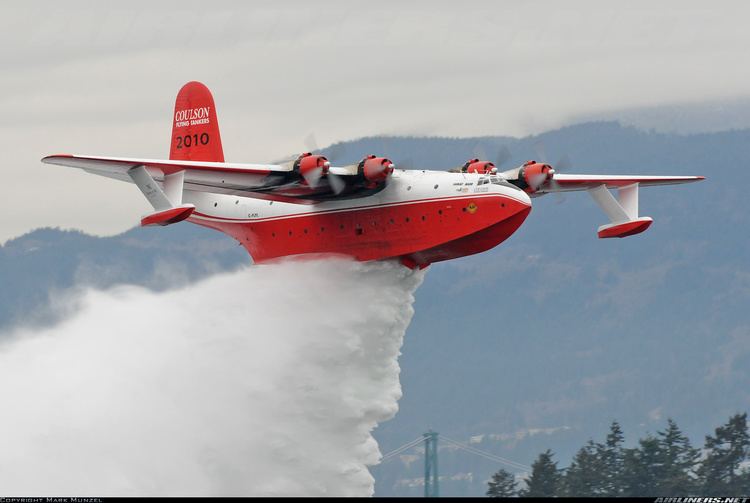
The Glenn L. Martin Company scaled up their PBM Mariner patrol bomber design to produce the prototype XPB2M-1 Mars. The XPB2M-1 was launched on 8 November 1941. After a delay caused by an engine fire during ground runs, the aircraft first flew on 23 June 1942. After flight tests with the XPB2M between 1942 and 1943, she was passed on to the Navy. The original patrol bomber concept was considered obsolete by this time, and the Mars was converted into a transport aircraft designated the XPB2M-1R. The Navy was satisfied with the performance, and ordered 20 of the modified JRM-1 Mars. The first, named Hawaii Mars, was delivered in June 1945, but with the end of World War II the Navy scaled back their order, buying only the five aircraft which were then on the production line. Though the original Hawaii Mars was lost in an accident on Chesapeake Bay a few weeks after it first flew, the other five Mars were completed, and the last delivered in 1947.
U.S. Navy service
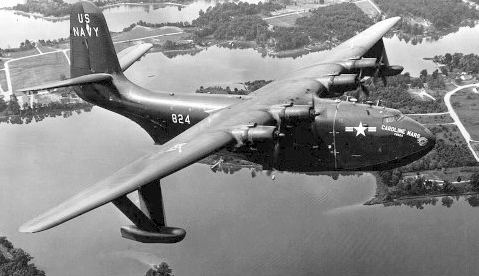
Named the Marianas Mars, Philippine Mars, Marshall Mars, Caroline Mars, and a second Hawaii Mars, the five production Mars aircraft entered service ferrying cargo to Hawaii and the Pacific Islands on 23 January 1944. The last production airplane (the Caroline Mars) was designated JRM-2, powered by 3,000 hp (2,200 kW) Pratt & Whitney R-4360 engines, and featured a higher maximum weight and other improvements. On 4 March 1949, the Caroline Mars set a new world passenger load record by carrying 269 people from San Diego to Alameda, CA. On 5 April 1950, the Marshall Mars was lost near Hawaii when an engine fire consumed the airplane after her crew had evacuated. The remaining "Big Four" flew record amounts of Naval cargo on the San Francisco-Honolulu route efficiently until 1956, when they were beached at NAS Alameda.
Civilian use
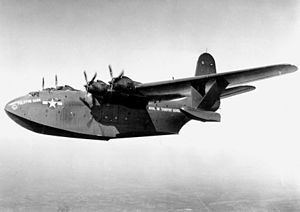
In 1959, the remaining Mars aircraft were to be sold for scrap, but a Canadian company, Forest Industries Flying Tankers (FIFT), was formed and bid for the four aircraft and a large spares inventory. The company represented a consortium of British Columbia forest companies, and the bid was accepted and the sale completed in December 1959. The four aircraft were flown to Fairey Aviation at Victoria, British Columbia, for conversion into water bombers. The conversion involved the installation of a tank in the cargo bay and retractable pick-up scoops to allow uploading of water while the aircraft was taxiing. The scoops allowed 30 tons of water to be taken on board in 22 seconds. Later some of the hull fuel tanks were replaced with water tanks.
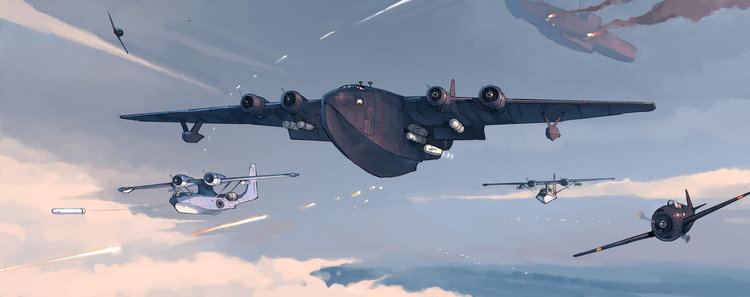
The Marianas Mars crashed near Northwest Bay, British Columbia, on 23 June 1961 during firefighting operations; all four crew members were lost. Just over a year later, on 12 October 1962 while parked onshore at the Victoria airport, the Caroline Mars was damaged beyond repair by Typhoon Freda when she was blown 200 yards, breaking her back. The Hawaii Mars and Philippine Mars had their conversion into water bombers advanced and entered service in 1963. They appeared at local airshows, demonstrating their water-dropping ability. Flying Tankers Inc. flew the water bombers to hot spots around the province when a need developed, such as in August 2003, when a large forest fire threatened the outskirts of Kelowna, British Columbia.
On 10 November 2006, TimberWest Forest Ltd. announced they were looking for buyers of the Mars. A condition of sale was that the purchaser would have to donate one plane back to Port Alberni when they were retired, as a historic attraction. The Maryland Aviation Museum and British Columbia Aviation Council initiated a joint effort to preserve the aircraft, one for display in Maryland and the other at the current location in Canada. On 13 April 2007, TimberWest announced the sale of both aircraft to Coulson Forest Products, a local forestry company in Port Alberni, British Columbia. The two surviving tankers are presently operated by Coulson Flying Tankers and are based and maintained at Sproat Lake near Port Alberni. On 25 October 2007, the Hawaii Mars ("Redtail") arrived at Lake Elsinore in southern California, on a private contract, to assist with firefighting efforts at the California wildfires of October 2007. Meanwhile, the Philippine Mars had been undergoing "extensive maintenance and renovation" and was expected to be ready to fly again by 2010. As of 13 August 2009, the Hawaii Mars was in service fighting the La Brea fire east of Santa Maria in Southern California.
The aircraft can carry 7,200 U.S. gallons (27,276 litres) of water and each drop can cover an area of up to 4 acres (1.6 hectares). The aircraft can also carry up to 600 U.S. gallons (2,270 litres) of foam concentrate for gelling the load drop. They are mainly used to fight fires along the coast of British Columbia and sometimes in the interior. As of July 29, 2010, the Martin Mars was being used to fight the Mason Lake/Bonaparte Lake fire north of Kamloops.
On 23 August 2012, the Coulson Group announced that the Philippine Mars, due to its lack of use for five years, would be retired and flown to the National Naval Aviation Museum at Naval Air Station Pensacola, Florida to become a static exhibit. The aircraft was repainted to its original U.S. Navy colors and was to have been delivered to the museum in November 2012. After many delays, the trade deal of transferring the aircraft to the museum was put on hold by the navy in June 2016, pending the outcome of the 2016 US Presidential election.
On 10 May 2013, the B.C. provincial government announced that the Hawaii Mars would no longer be placed on contract after the 2013 season, due to not having been used to fight any B.C. fires for two years and the operation of newer and more versatile aircraft by the Coulson group including a Lockheed C-130 Hercules converted to firefighting use. Although Coulson stated that the Hawaii Mars has been under numerous recent upgrades to make it safer and more reliable, no buyers have come forward to purchase the aircraft. Coulson also cautioned against any plans to open the aircraft as a tourist attraction because of the 2013 closure of the Flying Tankers Bomber Base Museum from poor attendance.
In May 2015, the Hawaii Mars received a small contract to be used briefly for training Chinese pilots. This was done using the Martin Mars to evaluate against civil certification regulations by The International Test Pilot School, on how to handle such a large amphibious aircraft. These pilots will be involved with the Chinese state owned Aviation Industry Corporation of China as they get ready to launch their forthcoming AVIC TA-600 airplane. Subsequently, in July 2015, the airplane was put back in service after public outcry, being awarded a 30-day contract from the BC Government to help with a particularly bad fire season.
In 2016, the Hawaii Mars made its first appearance at EAA AirVenture Oshkosh in hopes of being sold or leased to a new home or business. According to the Smithsonian Channel episode of Mighty Planes Martin Mars, only one Martin Mars is now flying.
Variants
Aircraft
Specifications (JRM-3 Mars)
Data from Jane’s Fighting Aircraft of World War II
General characteristics
Performance
